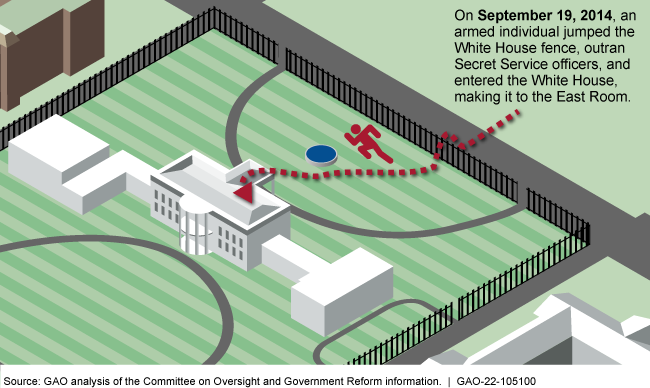U.S. Secret Service: Further Progress Made Implementing the Protective Mission Panel Recommendations
Fast Facts
In Sept. 2014, an intruder jumped a fence, passed several layers of security, evaded U.S. Secret Service personnel, and entered the White House before being detained.
In Dec. 2014, an independent panel of experts made 19 recommendations for improvements to the Secret Service. For example, the panel cited a "catastrophic failure of training" and recommended certain divisions train 25% of the time.
We found that the agency is working to address these recommendations. For example, in 2021, the Secret Service mandated that agents who protect the President and Vice President train for at least 12% of their work hours by FY 2025.
One example of a U.S. Secret Service Incident on the White House Complex

Highlights
What GAO Found
In December 2014, the U.S. Secret Service Protective Mission Panel—an independent panel of experts established to review White House security and other aspects of Secret Service operations—made 19 recommendations related to training and personnel, technology and operations, and leadership. The agency has made progress implementing the 19 Protective Mission Panel (Panel) recommendations. Specifically, the Secret Service has taken actions to address 13 of the 19 recommendations, including two since GAO's last assessment in 2019. For example, the agency revised its budget processes to incorporate principles of mission-based budgeting in its budget formulation process. In February 2019, the Secret Service formally incorporated a new budgeting process and, in August 2021, issued its Fiscal Years 2021-2025 Human Capital Strategic Plan , which includes revised staffing models to be used in developing the budget. In addition, the agency developed and implemented its Leadership Development System framework across all occupational categories in the agency. The framework is intended to promote leadership within individuals, teams, and projects and result in a positive effect on performance and agency mission accomplishment.
The Secret Service is in the process of implementing the remaining six recommendations. For example, the Panel found in its report that the security incident of September 19, 2014, when an intruder jumped the north fence and entered the White House, arose from a “catastrophic failure of training.” The Panel recommended that the Presidential and Vice-Presidential Protective Divisions train for 25 percent of their work time. In August 2021, the Secret Service, in consultation with the Department of Homeland Security and the Office of Management and Budget, established a new training target—at least 12 percent of work hours by fiscal year 2025—that takes the availability of resources into account. (See fig.).
Share of Regular Work Hours That Presidential and Vice-Presidential Protective Detail Agents Spent in Training, Fiscal Years 2014 through 2020

Why GAO Did This Study
The Secret Service, a component of the Department of Homeland Security is responsible for providing physical protection for the President, the Vice President, their immediate families, and visiting foreign dignitaries, as well as for the White House complex.
The Secret Service Overtime Pay Extension Act includes a provision for GAO to report on the extent of progress made by the Secret Service in implementing the Panel's recommendations. This report addresses the progress that the Secret Service has made toward implementing the Panel's recommendations. For this report, GAO reviewed relevant Secret Service planning and implementation documents, analyzed agency training data from fiscal years 2014 through 2020, and interviewed agency officials.
Recommendations
In prior work, GAO recommended that Secret Service: (1) develop and implement a plan to ensure that special agents assigned to the Presidential and Vice Presidential Protective Divisions reach annual training targets, and (2) develop and implement a policy that documents the process for collecting complete and appropriate data on Uniformed Division officer training. DHS concurred with the two recommendations and has taken steps to address them, but planning and policy development steps remain. We provided a copy of this report to DHS. On review of our draft report, DHS informed us it had no comment.
